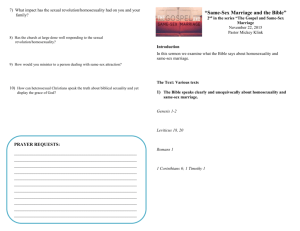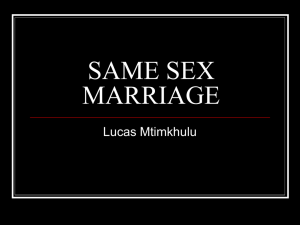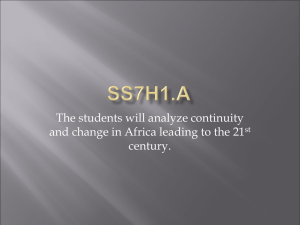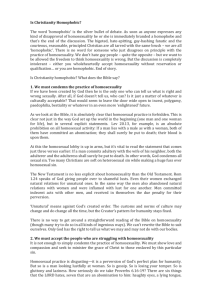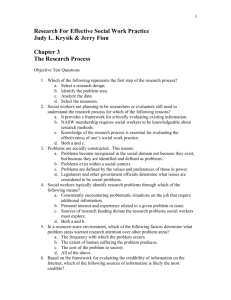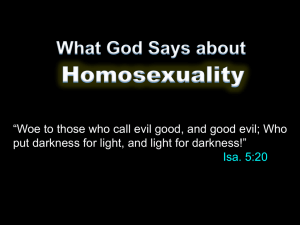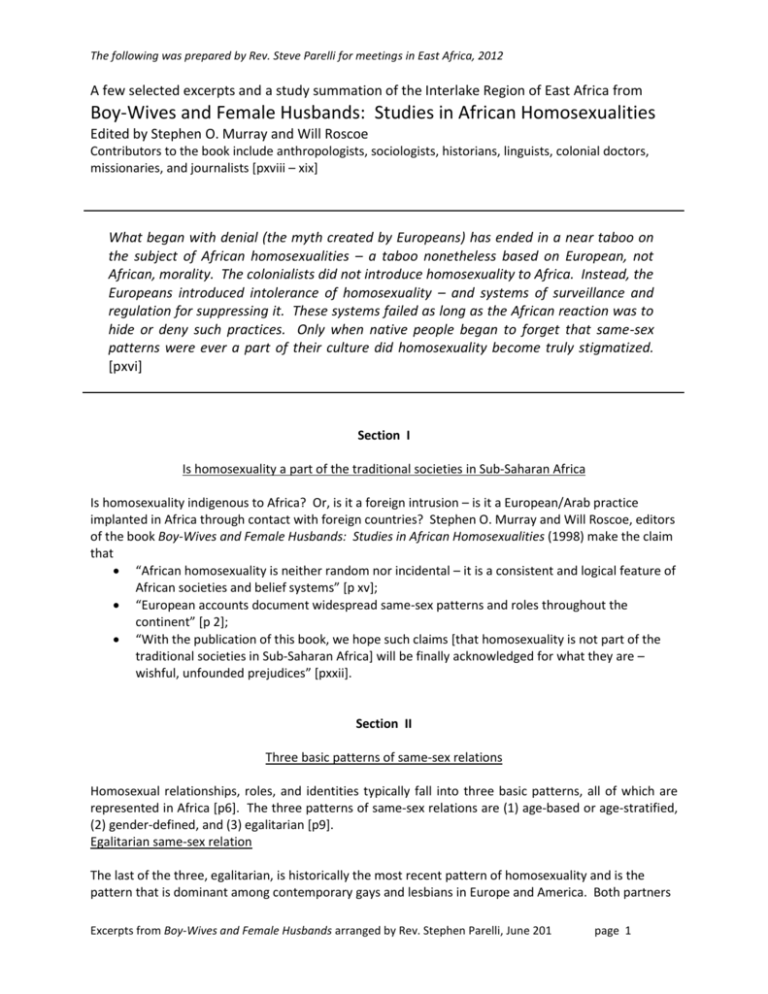
The following was prepared by Rev. Steve Parelli for meetings in East Africa, 2012
A few selected excerpts and a study summation of the Interlake Region of East Africa from
Boy-Wives and Female Husbands: Studies in African Homosexualities
Edited by Stephen O. Murray and Will Roscoe
Contributors to the book include anthropologists, sociologists, historians, linguists, colonial doctors,
missionaries, and journalists [pxviii – xix]
What began with denial (the myth created by Europeans) has ended in a near taboo on
the subject of African homosexualities – a taboo nonetheless based on European, not
African, morality. The colonialists did not introduce homosexuality to Africa. Instead, the
Europeans introduced intolerance of homosexuality – and systems of surveillance and
regulation for suppressing it. These systems failed as long as the African reaction was to
hide or deny such practices. Only when native people began to forget that same-sex
patterns were ever a part of their culture did homosexuality become truly stigmatized.
[pxvi]
Section I
Is homosexuality a part of the traditional societies in Sub-Saharan Africa
Is homosexuality indigenous to Africa? Or, is it a foreign intrusion – is it a European/Arab practice
implanted in Africa through contact with foreign countries? Stephen O. Murray and Will Roscoe, editors
of the book Boy-Wives and Female Husbands: Studies in African Homosexualities (1998) make the claim
that
“African homosexuality is neither random nor incidental – it is a consistent and logical feature of
African societies and belief systems” [p xv];
“European accounts document widespread same-sex patterns and roles throughout the
continent” [p 2];
“With the publication of this book, we hope such claims [that homosexuality is not part of the
traditional societies in Sub-Saharan Africa] will be finally acknowledged for what they are –
wishful, unfounded prejudices” [pxxii].
Section II
Three basic patterns of same-sex relations
Homosexual relationships, roles, and identities typically fall into three basic patterns, all of which are
represented in Africa [p6]. The three patterns of same-sex relations are (1) age-based or age-stratified,
(2) gender-defined, and (3) egalitarian [p9].
Egalitarian same-sex relation
The last of the three, egalitarian, is historically the most recent pattern of homosexuality and is the
pattern that is dominant among contemporary gays and lesbians in Europe and America. Both partners
Excerpts from Boy-Wives and Female Husbands arranged by Rev. Stephen Parelli, June 201
page 1
are members of the same social gender role. Differences of class, race, and age are not the formal basis
for organizing the relationship (although such differences may exist).
Tutsi boys during their training away from the village to become warriors often have sexual
relationships together, some of which last into adulthood [p39].
Age-based and gender-based same-sex relation
The first two patterns are both status-differentiated relations and much older than the equalitarian
pattern.
Age-based or age-stratified same-sex relation
In the age-based or age-stratified same-sex relation, one partner is older, though the difference is
usually not generational; both partners are regarded as still belonging to the same gender although the
younger partner is expected to be less masculine or overtly feminine.
When natives told Europeans that men had sex with boys “just because they like them,” the
Europeans were shocked, incredulous and confused [p2].
In non-Western societies in which arranged marriages prevail we [in the West] should not be
shocked to learn that in some African societies adolescent boys entered arranged relationships
with older men without being asked if they were willing or what their sexual preference was.
Such relationships had a wide range of meanings for their members – for some, being a boy-wife
was almost a kind of slavery, for others a deep bond of love [pxvii-xviii].
Gender-based same-sex relation
In the gender-defined same-sex relation, the active partner in intercourse is not marked or regarded
(especially not by himself) as homosexual whereas the penetrated partner acquires a distinct identity,
and is expected to conform to the behavior and social roles of women.
Andrew Battle, an English prisoner of the Portuguese in the 1580s reported “men in women
apparel, whom they keep among their wives” among the natives of the Dombe. [p2]
A warrior woman named Nzinga (c. 1581-1663), king (not queen) of the Ndongo kingdom of
Mbundu (Umbundu), successfully outmaneuvered the Portuguese for nearly for decades. In the
late 1640s, a Dutch military attaché observed firsthand her court. The woman-king ruled
dressed as a man, surrounded by a harem of young men who dressed as women and were her
“wives.” [p1] Early reports from Angola, make it clear that Nzinga’s behavior was not some
personal idiosyncrasy but was based on beliefs that recognized gender as situational and
symbolic as much as a personal, innate characteristic of the individual. [p2] Because of these
beliefs, there existed an alternative gender role among groups in the Kongo and Ndongo
kingdoms [p2].
Section III
Homosexuality in the Interlake Region of East Africa
Excerpts from Boy-Wives and Female Husbands arranged by Rev. Stephen Parelli, June 201
page 2
The book divides sub-Sahara Africa into four regions: (1) Horn of Africa, Sudan, and East Africa; (2) West
Africa; (3) Central Africa; and (4) Southern Africa. Citing first-hand and second-hand accounts from
historical and anthropological literature, the editors document each region’s indigenous patterns of
same-sex relations.
To illustrate indigenous homosexuality in Africa, let us consider the editors’ findings for the Interlake
Region of East Africa. In this instance, the editors report their findings per tribe. And they group their
tribes by language. Eleven Bantu language tribes are cited and seven Nilotes tribes (eastern Sudanic
languages). In addition, two court accounts, one prison account, and a Kenyan novel are cited.
As we reproduce an abridgement of the specific findings in this here, the reader may find himself placing
the given activity in one of the same-sex relation patterns mentioned early, or not. (In Appendix II,
pages 283-284, the editors list the African groups per same-sex patterns; all same-sex patterns identified
below are suggestive for illustrious purposes only without having checked the editors’ cataloguing.)
The dates given in parenthesis indicate the date of the writing being cited by editors of Boy-Wives etc.
For the actual author of the citing, go to http://semgai.free.fr/doc_et_pdf/africa_A4.pdf and “search”
the document per tribe.
The Nilotes Tribes
The Mandari view homosexuality as a ludicrous and non-productive act (1963). Group masturbation
occurs among young Iteso males in Uganda and Kenya (1973) [the equalitarian pattern]. Nkole
informants reported that the Bahima (but not themselves) practiced homosexuality (1973).
The Lango believe impotence is the basis for assuming the alternative gender status mudoko dako
[transformed man] and will treat the mudoko dako like a woman who may live as a legitimate wife to a
man (1923, 1937) [the gender-based pattern]. Lango informants report the Itesos and Karamojan
(Karimojong) practice the same:
Among the Iteso, people of hermaphroditic instincts are very numerous.... The men are
impotent and have the instincts of women and become women to all intents and purposes; their
voices are feminine and their manner of walking and of speech is feminine (1957) [the genderbased pattern].
During circumcision festivals, Nandi boys wear women’s clothes for about eight weeks (1909). A Nandi
boy’s affair with a white farmer continued even after the Nandi married (1933) [age-stratified pattern].
Nandi “homoerotic bacherlors” and Nandi women who satisfy each other using didoes, are reportedly
known (1939, 1964).
The Massia like to appear as women and wear earrings and garments reaching to the ground. When
they have all recovered they discard the long garments and wear warrior’s skins and ornaments (1905).
The Bantu Language Groups
The mugawe, a religious leader among the Meru of Kenya, are frequently homosexual and sometimes
are married to a man (1973). Their leadership role includes wearing women’s clothes and hairstyle.
Cross-dressing among the Gisu of Uganda (1959). Hutu and Tutsi gender-crossing priests called ikihindu
and ikimaze (1973).
Excerpts from Boy-Wives and Female Husbands arranged by Rev. Stephen Parelli, June 201
page 3
Active Kikuyu pederasts are called onek (1939, 1964) [age-stratified pattern].
An effeminate Wganda “totally given to passive pederasty” (1899) [gender-based pattern].
Among the Bagishu and Maragoli, hermaphrodites are quite numerous [1939) [gender-based pattern]
and are called inzili by the Bagishu and kiziri by the Maragoli.
For initiation into the Cwezi cult among the Nyoro, the novice is given to believe that he must
demonstrate his genuine possession by the spirits by becoming a woman.
An account of two boys lying together in bed making love, one a Mgisho and the other a Baganda (1939,
1964) [equalitarian same-sex pattern].
Tutsi boys during their training away from the village to become warriors often have sexual relationships
together, some of which last into adulthood (1986) [equalitarian same-sex pattern].
Some Kaguru women (of central Tanzania) practice lesbian activities during female initiation, women
taking both the roles of men and of women in demonstrating sexual congress to initiates.
Rundi Terms, Kenyan Novel, Uganda and Rwanda Royal Courts, and a Uganda Prison
Rundi terms – An early twentieth-century dictionary includes the Rundi terms umuswezi and
umukonotsi, translated “sodomite” and at least five Rundi words for male-male sexuality (kuswerana
nk’imbwa, kunonoka, kwitomba, kuranana inyuma, ku’nyo).
Lesbianism in a Kenyan Novel –Ripples in the Pool by Rebeka Njau, originally published in 1975, has
female-female passion as its theme. The moral of the story: Lesbianism is possible but wrong, and also
very dangerous [p39, 40]
Royal Courts – Uganda’s King Mwanga’s 1886 persecution of Christian pages was largely motivated by
their rejection of his sexual advances (1962). Male homosexuality was common among Hutu and Tutsi
youth, especially among young Tutsi being trained at court, i.e., they were made sexually available to
guests at court (1961).
A Uganda prison – The majority could understand but not tolerate homosexuality in others, and they
constantly referred to the practice in admonitory terms (in earshot of colonialists) (1969).
Section IV
The Myth that Homosexuality is Absent or Incidental in African Societies
The European Ideology behind the Myth
One of the oldest and most enduring myths Europeans created about Africa is the myth that
homosexuality is absent or incidental in African societies. According to European thinking, the African
Excerpts from Boy-Wives and Female Husbands arranged by Rev. Stephen Parelli, June 201
page 4
had to be heterosexual. By virtue of being the most primitive man, ruled by instinct, close to nature and
culturally unsophisticated, the African, according to the Europeans, had to be heterosexual. [pxi]
The 18ty Century Publication of the Myth
This sexualization of “primitive” Africans as heterosexual can be traced to Edward Gibbon’s comments in
in his History of the Decline and Fall of the Roman Empire. When it was published in 1781, hardly any
Europeans had traveled more than a few miles into the African interior. Still, Gibbon, wrote, “I believe,
and hope, that the negroes, in their own country, were exempt from this moral pestilence [i.e.,
homosexual ‘vice’]” [pxii].
The Failures of Anthropologists and the Difficulties they faced in Addressing the Myth
Rather than dispel the myth, anthropologists, like E. E. Evans-Prichard (1937), often reinforced it by not
seriously investigating same-sex patters and failing to report what they did observe [pxii-xiii]. Other
anthropologists, like Alan Merriam (1971) and Herskovits (1938), discounted or underplayed what they
reported [pxiii].
In all fairness to anthropologist, the earlier anthropologists were dependent on the approval and
support of white colonial regimes, contemporary anthropologists on the approval of black governments.
Given the overtly homophobic attitudes and policies of some African governments, it is not surprising
that few anthropologists have made African sexuality, let alone homosexuality, a focus of their research
[pxiv].
Native African denials of homosexuality need to be understood in the context of the African’s own
definitions of same-sex sex. For example, it is “all very confusing,” Brian MacDermont concluded. At
first, his informants assured him that in no uncertain terms sex between men simply did not occur
among the Ethiopean Nuer. Later, the explanation given for the context in which a man was married to
a man, MacDermont was told this is different because the man had actually become a woman, the
man’s status had changed from male to female, the spirits had declared that indeed the man was a
woman [pxiv-xv].
The Myth Vocalized in the West in Recent Decades
In 1990, a member of the rap group Public Enemy asserted, “There’s not a word in any African language
which describes homosexual. If you want to take me up on that, then you find me, in the original
languages of Africa, a word for homosexual, lesbian, or prostitute. There are no such words. They
didn’t exist.” [pxvi]
In 1987, Daniel B. Hrdy, in an article on cultural practices contributing to the transmission of the HIV
virus in Africa, and published by the University of California Davis Medical Center of Sacramento,
reported homosexuality is not part of traditional societies in Sub-Saharan Africa.” With the publication
of this book, we hope such claims will be finally acknowledged for what they are – wishful, unfounded
prejudices. [pxxii]
[Note: Hrdy’s article in which his unfortunate statement is found (see
http://www.cirp.org/library/disease/HIV/hrdy1/) also states: “However, a caveat must be
injected here: many field workers have noted that it is difficult to obtain accurate information
on sexual practices that Africans perceive to be offensive to Westerners. In addition,
homosexuality is illegal in many African countries. Moreover, there is a common desire for
Excerpts from Boy-Wives and Female Husbands arranged by Rev. Stephen Parelli, June 201
page 5
informants to answer any question with the answer that the questioner is perceived to want. An
accurate survey of homosexuality in urban areas has probably never been conducted.”]
Section V
Conclusion: Only when native people began to forget that same-sex patterns
were ever a part of their culture did homosexuality become truly stigmatized.
What began with denial (the myth created by Europeans) has ended in a near taboo on the subject of
African homosexualities – a taboo nonetheless based on European, not African, morality. The
colonialists did not introduce homosexuality to Africa. Instead, the Europeans introduced intolerance of
homosexuality – and systems of surveillance and regulation for suppressing it. These systems failed as
long as the African reaction was to hide or deny such practices. Only when native people began to
forget that same-sex patterns were ever a part of their culture did homosexuality become truly
stigmatized. [pxvi]
Excerpts from Boy-Wives and Female Husbands arranged by Rev. Stephen Parelli, June 201
page 6

